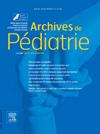Physiological and cerebral hemodynamic changes during routine nursing procedures for very preterm infants
IF 1.3
4区 医学
Q3 PEDIATRICS
引用次数: 0
Abstract
Background
Care procedures for preterm infants can induce stress that may disrupt homeostasis, possibly altering cerebral perfusion or oxygenation. We evaluated the physiological and cerebral oxygenation changes during the routine care of very preterm infants.
Methods
We analyzed the changes in heart and respiratory rates and in systemic and regional cerebral oxygen saturation of 27 very preterm infants, defining three care periods of 5 min each: 30 min before care, 30 min during care, and 30 min after care. Mean maximum and minimum values for each parameter during the defined care periods were compared by analysis of variance (ANOVA) for repeated measures.
Results
The mean heart rate was significantly higher during (160 ± 8 bpm) than before and after care (151 ± 21 and 151 ± 6 bpm, respectively). The mean respiratory rate decreased during care and increased afterward: 44 ± 2.2, 40.6 ± 3.2, and 46.7 ± 3.4 cycles/min, respectively (p < 0.05). The mean regional cerebral oxygen and systemic saturation did not vary significantly. Mean minimum and maximum values for each parameter varied during and after care as compared with before care (all p < 0.01). The mean minimum cerebral and systemic saturation was lower after care than before care: 59 ± 8 % versus 63 ± 8 % and 83 ± 3 % versus 90 ± 7 %, respectively (p < 0.05).
Conclusions
During routine care procedures for very preterm infants, the change in physiological parameters suggested an autonomic stress reaction. Cerebral desaturation may occur during and after the care of such infants and call for specific attention to better support the physiological and cerebral well-being of these infants during standard care procedures.
非常早产儿常规护理过程中的生理和脑血流动力学变化。
背景:早产儿的护理程序可能会引起压力,破坏体内平衡,可能改变脑灌注或氧合。我们评估了非常早产儿在常规护理过程中生理和脑氧合的变化。方法:分析27例极早产儿心脏、呼吸频率、全身和局部脑氧饱和度的变化,确定护理前30min、护理中30min、护理后30min三个5 min的护理期。通过重复测量的方差分析(ANOVA)比较定义的护理期间每个参数的平均最大值和最小值。结果:护理前后平均心率(160±8 bpm)明显高于护理前(151±21 bpm)和护理后(151±6 bpm)。护理期间平均呼吸频率下降,护理后平均呼吸频率上升,分别为44±2.2、40.6±3.2、46.7±3.4次/分(p < 0.05)。平均区域脑氧和全身饱和度无显著差异。与护理前相比,护理期间和护理后各参数的平均值最小值和最大值有差异(均p < 0.01)。护理后平均最低脑饱和度和全身饱和度低于护理前,分别为59±8%比63±8%和83±3%比90±7% (p < 0.05)。结论:在对极早产儿的常规护理过程中,生理参数的变化提示自主神经应激反应。脑去饱和可能发生在这些婴儿的护理期间和之后,需要特别注意在标准护理程序中更好地支持这些婴儿的生理和大脑健康。
本文章由计算机程序翻译,如有差异,请以英文原文为准。
求助全文
约1分钟内获得全文
求助全文
来源期刊

Archives De Pediatrie
医学-小儿科
CiteScore
2.80
自引率
5.60%
发文量
106
审稿时长
24.1 weeks
期刊介绍:
Archives de Pédiatrie publishes in English original Research papers, Review articles, Short communications, Practice guidelines, Editorials and Letters in all fields relevant to pediatrics.
Eight issues of Archives de Pédiatrie are released annually, as well as supplementary and special editions to complete these regular issues.
All manuscripts submitted to the journal are subjected to peer review by international experts, and must:
Be written in excellent English, clear and easy to understand, precise and concise;
Bring new, interesting, valid information - and improve clinical care or guide future research;
Be solely the work of the author(s) stated;
Not have been previously published elsewhere and not be under consideration by another journal;
Be in accordance with the journal''s Guide for Authors'' instructions: manuscripts that fail to comply with these rules may be returned to the authors without being reviewed.
Under no circumstances does the journal guarantee publication before the editorial board makes its final decision.
Archives de Pédiatrie is the official publication of the French Society of Pediatrics.
 求助内容:
求助内容: 应助结果提醒方式:
应助结果提醒方式:


